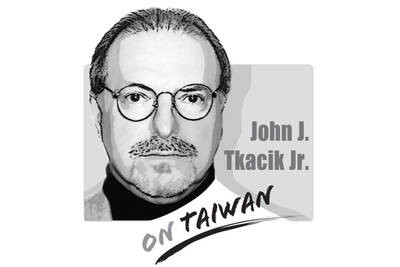The army’s long-awaited first shipment of 38 of the 108 ordered US-made M1A2T tanks arrived on Sunday last week. The same shipment also included four M88A2 armored recovery vehicles. The M1A2T is not only the most powerful tank available, it is also the first new model procured by our military in more than 30 years. Its maneuverability, firepower and defensive capabilities far outstrip those of the armored units currently in service. In facing the threats posed to Taiwan by the People’s Liberation Army (PLA) and its air-cushioned landing crafts, the M1A2T could hold off such forces with its overwhelming superiority.
Naysayers spreading a narrative centered on the “uselessness” of tanks in Taiwan believe that this shipment — and its procurement — is inappropriate for our military. They go as far as to argue that the M1 Abrams family of tanks, including the M1A2T variant, are unsuited to take on the threat of aerial drones on modern battlefields.
Taiwan’s infrastructure and topography as well as the appearance of other modern battlefields suggest otherwise.
Based on recent news stories about the M1A2T’s arrival, none of the asphalt roads sustained damage during transfer and delivery or during autonomous drive tests. Despite the M1A2T weighing about 63 tonnes, Taiwan’s asphalt roads are durable enough to handle the load and the tanks’ continuous track treading. Heavily laden dump trucks and other large trucks transporting gravel and sand frequently travel long distances along Taiwan’s roads, and they seem to have little or no impact. Several of our highways are also capable of bearing the weight, as proven by the newly arrived tanks. The claim that the M1A2T is too heavy to be suitable for the country’s defense is simply untrue.
Second, the coastal plains of Taiwan’s main island might be far smaller than those in the US, Russia and Europe. However, the land armies of other small and compact nations, and those that might have a high degree of mountainous terrain, such as Japan, South Korea, Singapore and Switzerland, all use heavy tanks in their main forces.
Our army has a need for heavy tanks to carry out national territorial defense operations. When combined with round-wheeled armored vehicles and armed helicopters, the M1A2T is not only suitable for Taiwan, but it directly improves and increases the overall level of our army’s defense operations capabilities.
Third, during Russia’s invasion of Ukraine, aerial drones and uncrewed vehicles have been capable of striking and destroying tanks, that much is true.
However, that argument is not the same as saying that the role of tanks in modern warfare has completely fallen to the wayside.
On offense and defense, tanks are winning pieces of war equipment. Outfitting our army with Abrams tanks for hypothetically defensive operations could show off its dual offensive and defensive capabilities.
Fourth, as each batch of the army’s M1A2Ts are successively delivered, they would continue to seamlessly improve defensive operations in northern Taiwan. The deployment of the heavy tanks by the army’s 584th Armored Brigade and the 269th Mechanized Infantry Brigade, based near Hukou (湖口) and Yangmei (楊梅) townships respectively, would enhance the 6th Army Corps’ ability to guard the capital, while augmenting northern Taiwan’s comprehensive defense resilience.
Lastly, looking broadly at the proven operational capabilities of tanks from around the world, the performance of the US-made M1 Abrams tank and its variants is generally superior to that of heavy tanks manufactured by Russia or other undemocratic countries.
Ray Song is a doctoral student at Tamkang University’s Graduate Institute of International Affairs and Strategic Studies.
Translated by Tim Smith

On May 7, 1971, Henry Kissinger planned his first, ultra-secret mission to China and pondered whether it would be better to meet his Chinese interlocutors “in Pakistan where the Pakistanis would tape the meeting — or in China where the Chinese would do the taping.” After a flicker of thought, he decided to have the Chinese do all the tape recording, translating and transcribing. Fortuitously, historians have several thousand pages of verbatim texts of Dr. Kissinger’s negotiations with his Chinese counterparts. Paradoxically, behind the scenes, Chinese stenographers prepared verbatim English language typescripts faster than they could translate and type them
More than 30 years ago when I immigrated to the US, applied for citizenship and took the 100-question civics test, the one part of the naturalization process that left the deepest impression on me was one question on the N-400 form, which asked: “Have you ever been a member of, involved in or in any way associated with any communist or totalitarian party anywhere in the world?” Answering “yes” could lead to the rejection of your application. Some people might try their luck and lie, but if exposed, the consequences could be much worse — a person could be fined,
Xiaomi Corp founder Lei Jun (雷軍) on May 22 made a high-profile announcement, giving online viewers a sneak peek at the company’s first 3-nanometer mobile processor — the Xring O1 chip — and saying it is a breakthrough in China’s chip design history. Although Xiaomi might be capable of designing chips, it lacks the ability to manufacture them. No matter how beautifully planned the blueprints are, if they cannot be mass-produced, they are nothing more than drawings on paper. The truth is that China’s chipmaking efforts are still heavily reliant on the free world — particularly on Taiwan Semiconductor Manufacturing
Last week, Nvidia chief executive officer Jensen Huang (黃仁勳) unveiled the location of Nvidia’s new Taipei headquarters and announced plans to build the world’s first large-scale artificial intelligence (AI) supercomputer in Taiwan. In Taipei, Huang’s announcement was welcomed as a milestone for Taiwan’s tech industry. However, beneath the excitement lies a significant question: Can Taiwan’s electricity infrastructure, especially its renewable energy supply, keep up with growing demand from AI chipmaking? Despite its leadership in digital hardware, Taiwan lags behind in renewable energy adoption. Moreover, the electricity grid is already experiencing supply shortages. As Taiwan’s role in AI manufacturing expands, it is critical that